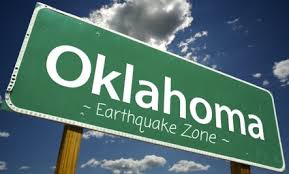
Scientists aren’t finished studying earthquakes and their connection to wastewater disposal wells.
A new study in the journal Science reveals how quakes are caused miles away from the wastewater wells in Oklahoma, Texas, Kansas and California. Now those quakes are also happening along the east coast where there is also drilling and the need to dispose of the saltwater that comes with the crude oil according to a recent report in the Washington Post.
“Induced earthquakes are becoming more and more of an issue in central U.S. and the eastern U.S.,” said University of California at Santa Cruz seismologist Thomas Goebel. In 2011, an injection well in Oklahoma was responsible for a magnitude 5.6 earthquake, which damaged a highway, shook buildings and generated a dozen aftershocks.
To figure out how there could be such a distance between well and earthquake, Goebel, along with fellow University of California at Santa Cruz earthquake expert Emily Brodsky, sifted through quakes triggered by dozens of waste injection sites in several states as well as Australia and Europe. (There are so many wells in Oklahoma they could not link an individual well to the surrounding earthquakes.)
Industrial techniques like hydraulic fracturing, or fracking, shove water underground to force oil and gas out of shale deposits. Most induced earthquakes are not a result of fracking itself but wastewater generated at the oil and gas wells. Some of that water can be reused or treated. The rest is buried in wells.
Earthquakes occur when a crack underground — a fault — pulls apart. A few decades ago, when scientists were beginning to understand that humans could generate earthquakes, the idea was “you put water directly into the fault,” said Brodsky. It was assumed water would pry apart the fault, like a hydraulic jack lifting a car, triggering a quake.
But that theory couldn’t explain the quakes that happen miles from the wells.
The study authors were able to identify two types of earthquakes triggered by wastewater wells, having everything to do with what kind of rock the water is being injected into.
One kind of earthquake formed close to the injection well, but stopped abruptly at about a half-mile from the site, Goebel said. If a well dumped its wastewater into rigid bedrock, earthquakes occurred within a close distance. There, pressure from water that spilled into a fault triggered the earthquake.
The other kind had a “very long-distance tail” — the quakes could appear far from the well, with the triggers petering out only after several miles. This occurred if a well dumped its wastewater into softer sedimentary rock. This is was a result of what the researchers called poro-elasticity.
Unlike solid bedrock, sedimentary rocks have lots of holes, like a sponge. Because sedimentary rock is more permeable than bedrock it makes sense to dispose of fluid there — more holes mean more space for wastewater.
But the new study suggests energy companies are injecting waste into the wrong place to avoid earthquakes. Sedimentary rocks aren’t completely rigid. They’re squishy. They deform. Wastewater might not shove open a fault in the squishy rocks, Brodsky said, but as the ground fills with water “it also pushes on the surrounding rocks.”
Goebel likened it to stepping on a latex balloon sitting in a cardboard box. The balloon bulges outward, and as it does, it presses against the walls of the box. Likewise, as the rock bulges, it can nudge faults far from the injection well. The result: Seismic action at a distance.






